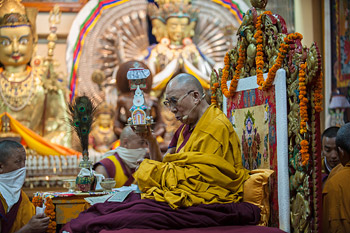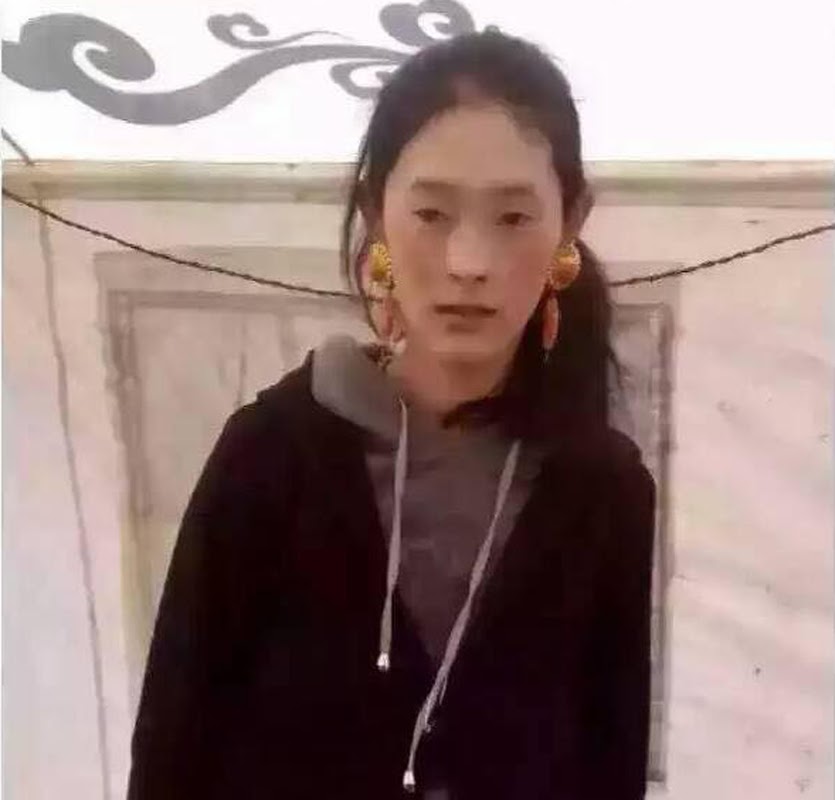Eleven Organizations Make a Long-Life Offering to His Holiness the Dalai Lama
[dalailama.com] Thekchen Chöling, McLeod Ganj, Dharamsala, HP, India, 20 July 2015 – To begin with this morning, His Holiness the Dalai Lama took his seat below the Tsuglagkhang to observe debates performed by monks and nuns from Nepal. They came from Kopan Monastery, Shelkar Chöde, Chuwar Gaden Dropen Ling, Shri Chusang Gompa, Samtenling Drubgön, Thukje Chöling, Serkong Gaden Jamgonling, and Gosok Phuntsok Chöling, as well as two nunneries, Kyirong Thukje Chöling and Kopan Khechö Gakyil Ling.
They also submitted a report of their studies and activities. His Holiness commended them, noting that 40 years ago he had advised that even monasteries engaged mostly in performing rituals and nunneries should introduce programs of study. He told them that they not only need to study, reflect and meditate, they also need to integrate what they know in practice.
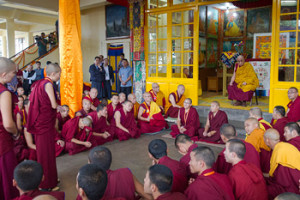
From the throne in the Tsuglagkhang, His Holiness announced that eleven different organizations had submitted requests to make a Ten-shug or Long-Life Offering. They included the Gelug Association of Nepal, the Tibetan Youth Congress, people of U-Tsang province, Shang Gaden Chökhor Ling, the Taglung Kagyu Tradition, the Tibetan Women’s Association, the Guchusum Movement, the Ngari Chithun Association, the Lodrik Association of Pokhara, Nepal, the Middle Way People’s Association and the Himalayan Buddhist Cultural Society. Since there was insufficient time for each of them to make a separate offering, they had all been brought together today.
“Today, the fourth of the sixth Tibetan month, is when we celebrate the Buddha’s first teaching,” His Holiness told the packed crowd. “He manifested as an emanation body, which can be seen by ordinary people, and lived the life of a prince. Once he’d seen the four signs – birth, aging, sickness and death – he renounced the royal life and undertook austerities for six years. Meditating on selflessness he attained enlightenment and then sharing what he’d experienced with others, he revealed the path.
“There were three Turnings of the Wheel of Dharma. In the first the Buddha taught the Four Noble Truths, in the second the Perfection of Wisdom and in the third the nature of the mind and Buddha nature. While the first Turning of the Wheel took place in public, the second was revealed only to a select group of disciples.
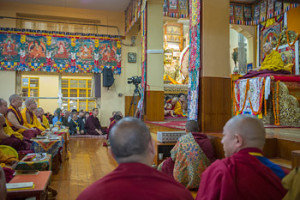
Photo/Tenzin Phuntsok/OHHDL
“Today, commemorating the First Turning of the Wheel of Dharma is an auspicious day. I’ll give a long-life empowerment related to the White Tara Wish-fulfilling Wheel, and along with that we’ll conduct a ceremony for generating the awakening mind. After that you can perform the long-life offering.”
His Holiness spoke about the Tibetan Buddhist tradition having its origins in the Nalanda tradition, which was characterized by a sceptical analysis of the teachings. This was in accord with the Buddha’s own advice to his followers not to accept his teaching out of reverence for him, but only once they had convinced themselves of its integrity through analysis. He said that while the Tibetan word ‘chö’ has a connotation of transformation, the Sanskrit term ‘Dharma’ has a sense of restraint, withholding and protection.
He pointed out that all 7 billion human beings alive today want happiness and don’t want suffering. And yet today’s education systems seem to be dedicated only to material development, which is inadequate. What we need in addition, he said, is a sense of inner peace, mental peace. To achieve that we need to counter our disturbing emotions which are among the factors that destroy it. His Holiness suggested that although circumambulation and prayer have value, they won’t help us overcome ignorance. Only wisdom and intelligence can do that. Although love and compassion are common to all religious paths, only Buddhism teaches a wisdom that overcomes the ignorance that involves a misconception of reality.
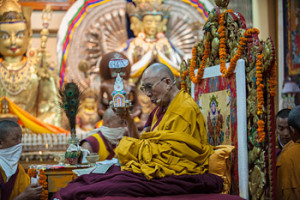
“In their report downstairs just now the monks and nuns from Nepal referred to an ongoing dialogue between Buddhism and science. I prefer to talk about a conversation involving Buddhist science and modern science. Where quantum physics says things lack any objective existence, for example, the Mind Only school says nothing has any external existence. What I wonder is whether such an understanding in a quantum physicist’s mind has any effect on his or her disturbing emotions?
“Tibetan Buddhism is vast and profound, but we should cultivate it on the basis of understanding, not on the excuse that it is what our parents believed. When Mao Zedong told me that religion is poison, I think he was referring to following religion with blind faith.
“For forty years or so, I’ve urged monasteries where there was no tradition of study to introduce it. These days I urge lay people to study too and increasingly many are doing so. The Nalanda tradition placed emphasis on logic and epistemology, which deals with the nature, sources and limits of knowledge. We Tibetans have kept it up. This is our treasure; it can be a treasure for the world too.”
His Holiness expressed gratitude for the kindness Tibetans have received from the Himalayan peoples. The many monks who have joined the re-established Tibetan monasteries have derived benefit themselves, but have also been helpful to the tradition. He mentioned Gyumey Lama Umzey, Gyen Lobsang, Shartse Abbot Jangchub Chöden, Chosphel Zotpa and Ganden Tri Rinpoche, Rizong Rinpoche as examples. He also recalled a story from the late Bakula Rinpoche’s childhood at Drepung Monastery in Tibet. When Rinpoche’s teacher scolded him for something Rinpoche apologised and asked to be excused because he came from a borderland. These days, His Holiness remarked, Ladakh is more like a central land.
“Although we are refugees,” His Holiness said, “we have preserved our traditions and shared them with the world.”
When he began to give the White Tara long-life empowerment, including a ceremonial generation of the awakening mind of bodhichitta, he remarked that if we are to put the vast and profound teachings of the Buddha into practice we need to have a long life. He advised that if we can it is important to maintain a clear mind from childhood.
“If you don’t die in the next couple of months, you may be able to create the causes for good rebirth. If you don’t die for the next couple of years, you might be able to create the causes of lasting happiness, “ he said.
The moment the White Tara empowerment was complete, the assembly began to perform the long-life offering. During the customary procession to present symbolic and actual offerings, about 1300 people from the 11 participating organizations passed through the temple, many of them looking eagerly towards the throne in hope of catching His Holiness’s eye. In the course of this happy occasion His Holiness remarked that while many regard their 81st year as unfavourable, for him it has been most auspicious. Long after he had returned to his residence, and despite the rain, people who had taken part in the ceremonies continued to sing and dance in the temple yard.

